- Bernard Preston homepage
- What's potting?
- Whats Potting in the Spring Garden
What's potting in the spring garden?
What's potting in the spring garden is all about getting that seed in early; if you have the space then corn and potatoes are lovely unless you are banting. Spinach, lettuce and radish are a must for every home. Fresh-herbs are fantastic.
It's that season when you will need to bend your back and get those seeds in; as soon as the danger of frost is over. So, before venturing to the shed for spades and forks, do the little exercises you will find lower down; they take less than one-minute.
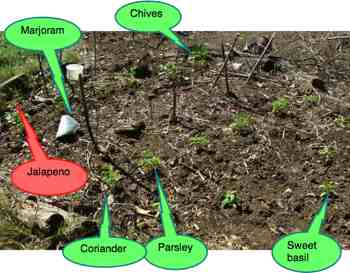
You may want to purchase some seedlings from your local nurseryman; they cost a few dollars but it saves you time. For example, I bought some herbs. Within two weeks we were able to take small snips of parsley, sweet basil and coriander for our salads. Water them daily if there's hot weather; perhaps even morning and noon.
Last year's jalapeno is shooting, so I won't have to buy any. And I'm also trying to grow some new plants from last year's seed.
- Bernard Preston homepage
- What's potting?
- Whats Potting in the Spring Garden
Marjoram is a new herb to us; thank you, Margo, for the seedling. She likes it freshly chopped with a chicken-dish and beef mince; it's under that cap to shade it from the hot sun for a few days.
Sweet basil makes any salad, particular if you take five minutes to rustle up a pesto; it's so easy.
If I've learnt one thing this spring, it's the value of a good nursery. I have tried growing our jalapenos from our own seed, but it has been a very cool season. It is Christmas and my seedlings are only 6" high. Last year I was already enjoying a chili a day in my green-salad.
Alternatively start some seedlings like chillis in a warm spot, away from the frost; a greenhouse is a consideration for the future.
"There are short-cuts to happiness, and gardening is one of them."
- Bernard Preston
What's potting in the Spring garden
Of course, what you plant is determined by your own favourites, the climate and the size of the patch. What's potting in the spring garden here in Southern Africa may be quite different to yours.
My strong suggestions are that you have pole beans, lettuce, spinach and radish in your small garden. A backyard patch like this incidentally will provide three of the four vitamins needed to prevent frailty syndrome.
Vitamin E is the missing one; we get it from our 100% wholemeal bread.

It's astonishing how much food you can get from one single spinach plant; a row one metre long will provide you with eggs Florentine every single morning for breakfast.
If you're banting, then just one egg dropped into a bed of lightly steamed green leaves has virtually zero carbohydrate. I have it on a slice of low GI bread, with butter, of course. There's no place for hydrogenated margarine in any health conscious kitchen.
The Banting diet is decidedly dangerous if you don't get a rich supply of vitamins B6 and 12 and choline due to a build up of homocysteine. So the egg and spinach breakfast is just perfect.
Interestingly the American Heart Association has come full circle; like butter, eggs are back.
In a larger garden like ours you can be more adventurous; this spring we
also have corn, lima beans, zuccini and butternut. In the next few weeks we'll plant sweet potato runners, pepperdews, eggplant and tomatoes too; and perhaps a Queensland blue pumpkin.
So make a spot for a compost pile. In the smaller garden, a compact tumbler is an option but they are really quite expensive; yet neat and tidy. Into it you could put your grass clippings and raw waste from the kitchen; potato peels, lemon rinds, eggshells, and aubergine skins, for example.
Then it's time to enrich your fruit trees. If you're totally organic, then just a thick layer of compost; I cheat and add a couple cups of inorganic lime, and nitrogen rich fertilizer too. We particularly love our avocados and citrus; they are amongst the richest sources of oleic acid for your nerves and vitamin C.
Last year we grew a hugely successful potato crop, with compost and some added inorganic nitrogen. Now I'm planting four rows, two with fertilizer and two with bush beans.
All four were heavily composted last year and, thereafter we had a crop of green peas; they fix nitrogen from the atmosphere. Legumes attract clever little bacteria that enrich our plants; lightening is the other source.
How to plant potatoes
How to plant potatoes is in the first instance hard work; you've got to dig a trench. Before asking what's potting in the spring garden enquire of yourself if you're willing to go through a warm up routine, same as if you were preparing for a football match?
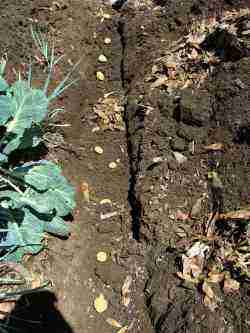
Now, for those lower back exercises; there are dozens to choose from.
It's some years since I wrote this page, and there have been numerous developments.
Firstly, moles have discovered that our garden is a veritable paradise, with rows of good food just waiting to be enjoyed; once they find the first potato plant, they just continue down the row of already softened soil. This year we harvested only half a pocket from a whole pocket of seed potatoes. What has kept us going on new potatoes have been the random spuds that were never harvested properly coming up in all the old beds.
Next year we will spread the seed here and there throughout the garden; that's been a great success and thwarted the moles. Better still these new potatoes, harvested straight from the garden don't spike my blood glucose like those that have been in cold storage.
Secondly there has been new understanding about the role white potatoes have in inflammation, in particular in relation to colorectal cancer; absorbed in the small intestine they break down rapidly to glucose which causes an insulin cascade.
There are three possible solutions:
- Change to the less starchy red potatoes.
- Enjoy new potatoes.
- Cool the boiled potatoes overnight, reheat and exploit the retrograded starch that passes through the small intestine to the colon where it enhances the anti inflammatory effect of the microbiota that produce little or no glucose, but rather healthy short chain fatty acids.
Meantime, grasp more about resistant starch.
Growing lettuce
Growing lettuce is so rewarding, but don't plant, or eat, iceberg is my advice. First in line at what's potting in the spring garden should be the dark green leafy vegetables.
Cos lettuce, also known as romaine, kale and spinach are amongst the best examples.
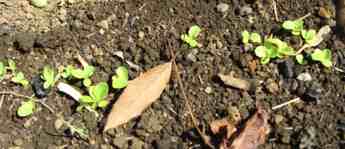
These don't look like much, but within a month we'll be eating a salad a day. Those I planted in the autumn garden have given us abundant lettuce; and I mean abundant. They are beginning to bolt in the hot late spring weather, but we still have more than enough for a salad a day; this little patch, and another just like it, have fed us for five months.
What's potting in the spring garden is such fun. It's all part of our philosophy of backyard permaculture; working with nature instead of against it.
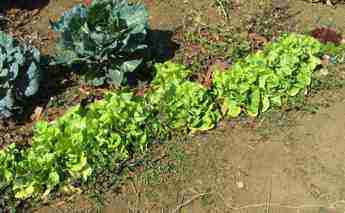
Growing green beans
I used to think growing green beans was a cinch; until the Mexican beetle arrived. After three miserable consecutive years, it looks like we have the solution; free-range hens. They clean up the cutworms too, turning them into delicious golden yolked eggs. One has to keep thinking and planning with what's potting in the spring garden.
Newsletter
Our newsletter is entitled "create a cyan zone" at your home, preserving both yourself and Mother Earth for future generations; and the family too, of course. We promise not to spam you with daily emails promoting various products. You may get an occasional nudge to buy one of my books.
Here are the back issues.
- Lifestyle and ideal body weight
- What are ultra-processed foods?
- Investing in long-term health
- Diseases from plastic exposure
- Intensive lifestyle management for obesity has limited value
- A world largely devoid of Parkinson's Disease
- The impact of friendly bacteria in the tum on the prevention of cancer
- There's a hole in the bucket
- Everyone is talking about weight loss drugs
- Pull the sweet tooth
- If you suffer from heartburn plant a susu
- Refined maize meal and stunting
- Should agriculture and industry get priority for water and electricity?
- Nature is calling
- Mill your own flour
- Bake your own sourdough bread
- Microplastics from our water
- Alternative types of water storage
- Wear your clothes out
- Comfort foods
- Create a bee-friendly environment
- Go to bed slightly hungry
- Keep bees
- Blue zone folk are religious
- Reduce plastic waste
- Family is important
- What can go in compost?
- Grow broad beans for longevity
- Harvest and store sunshine
- Blue zone exercise
- Harvest and store your rainwater
- Create a cyan zone at your home
The first bush beans are just up; tomorrow I'll take a photo. I have four rows, each three metres long; they will be ready to harvest in two months.
The pole beans are just up too; but they take three months to maturity. The advantage is a much greater yield and you don't have to break your back picking them.
The lima beans are up too and looking great; they have a long growing season and are a bit finicky to pod, but sufferin' succotash makes it worth the effort; I just love limas; the green ones, not the pink speckled; those are very starchy.
Even if you are obese I recommend you eat plenty of legumes.
I find it interesting that the only two veg that the hens go for are the green beans and tomatoes. They too need vegetable protein, same as we do. Working with nature means allowing the hens into the beans if you want top quality eggs, rich in omega-3.
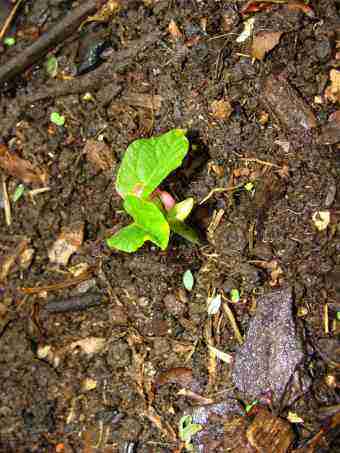
The first bush bean seedling. 60 days to first fruit. It's back breaking to pick them, but you can use them to put nitrogen into the soil where there are no fences or poles for climbing beans; and they'll be ready for harvesting a full month before the climbers.
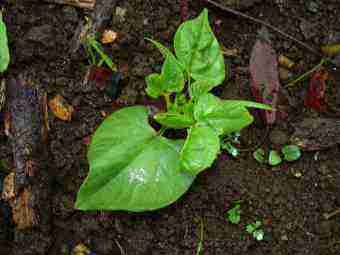
The first pole bean seedling. 90 days to first fruit. So, why grow pole beans? They are much more prolific, and are easier to reap.
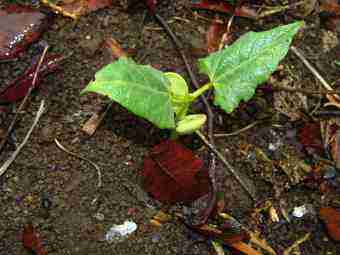
There's quite a lot going against lima beans; they take three months and longer to the first fruit, are quite difficult to find and reap, and to pod. But the taste is wonderful, and if you're trying to build a wide range of foods then there's certainly a place for them in the big spring garden.
This is what we can expect to begin in about two months after you began whats potting in the spring garden.
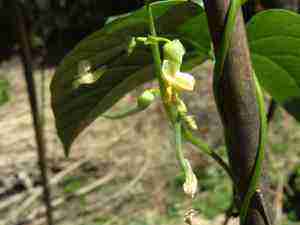
How to plant broad beans is important in spring and autumn; they are particularly high in vegetable protein; eaten young and fresh from the garden they are delicious. Thay are also one of the very few sources of L-dopa and give far better control of Parkinson's disease than taking medication.
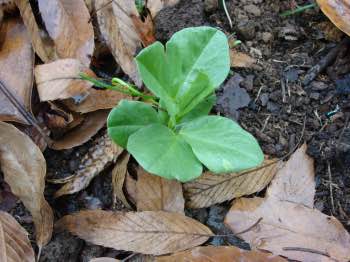
How to grow radishes
I've been a bit lax with how to grow radishes this year; we have just a few plants coming up; tomorrow I'll plant more. Radish take only 3-4 weeks to mature and add a bit of spice to any dull salad. What's potting in the spring garden is a rewarding time.
- How to grow radishes
- Make your own pesto with Janet and Santie.
Use the Site Search function in the navigation bar on your left to find the links to those topics highlighted in bold.
Compost pile
The compost pile is at the heart of the organic veggie patch; not only does it use up all the waste grass cuttings and clippings, but it provides the rich material for the next generation of plants; a vital part of what's potting in the spring garden.
They look a little untidy, so build it in a back corner; they have absolutely no smell. I'm going to boast a little; we have six going at any one time.
This is what the end product looks like. It's been said that you shouldn't use orange peels in the pile; absolute nonsense. Best of all is a very faint citrus scent from the compost.
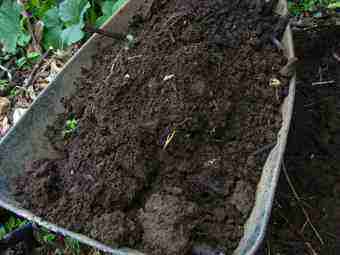
Enjoy rendering your own edition of what's potting in the spring garden; there's a time for sowing, and a time for reaping. Spring is the sowing season.
Oh, and yes, of course, what's potting; the web has a pet dislike for our little apostrophe.
How to grow corn
Corn, or mealies as we call them in South Africa, is only for the larger garden. I have about 250 plants growing in five different plantings about two weeks apart; that's enough for two corn on the cob for she who must be obeyed and I for four months. Less a few that the vervets will steal. Nevertheless they are an annual part of whats potting in the spring garden; I just love corn.
How to grow corn is simple; plant a seed, come back in about three months and harvest the cob.
This year we are planting even more to feed the hens; they are desperate for fresh corn for zeaxanthine, amongst other things, the carotenoid that prevents macular degeneration. A bird that can't see soon dies; we just become miserable.
There's a terrible blight of army worms in central and southern Africa this year, 2017. Tons of insecticides are being poured in, killing friend and foe alike; they destroy our immune systems too.
I wonder if any research has been done with releasing caged hens into the corn fields. If they can deal with the Mexican bean beetle so effectively, I wonder if they can't eradicate the army worm.
Of course, we put the hens in first this year to clean up the larvae, and only then planted the seed; what a success story. Could it be done on a macro scale? That's a job for the agricultural researchers.
Peppers and chilies
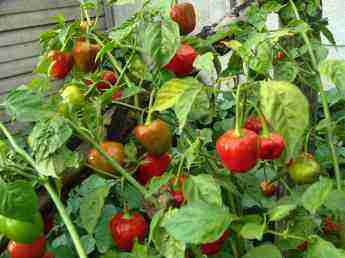
Because they are a very rich source of both vitamin C and capsaicin, a potent anti-inflammatory and painkiller, peppers and chilies are an important part of what's potting in the spring garden for us. They have a long growing season, and it's best to start them in a hothouse or warm spot.
Growing peppadews are our favourite; they a bit hot but don't burn the roof off your mouth.
Useful links
- How to grow chilli
- How to start beekeeping.
- What's potting in the garden home page.
- Free range eggs
- Roasted butternut squash recipe
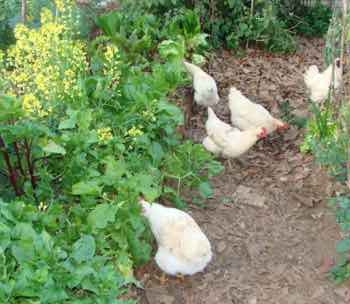
Hens love their dark green leafy vegetables and all manner of worms, larvae and beetles, turning them into golden-yolked eggs, rich in choline and vitamin B12. They amply illustrate the synergy of green living.
Did you find this page interesting? How about forwarding it to a friendly book or food junkie? Better still, a social media tick would help.
- Bernard Preston homepage
- What's potting?
- Whats Potting in the Spring Garden
Address:
56 Groenekloof Rd,
Hilton, KZN
South Africa
Website:
https://www.bernard-preston.com